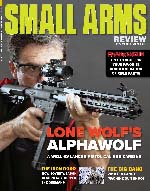The American FN FAL Rifle
By Frank Iannamico
In Search of the Perfect Lightweight Rifle
During World War II, the U.S. Ordnance Department began a research and development program for a new lightweight infantry rifle. After the war ended, progress was slowed due to reduced post-war funding for the project.
Early weapons developed during the program were based on the M1 Garand rifle, which slowly evolved into the T44 series of rifles, ending with the T44E4. One of the more serious competitors facing Springfield Armory’s T44E4 was the Belgian-designed Fusil Automatique Leger or FN FAL rifle.
During 1954, the U.S. placed an order with Fabrique Nationale of Herstal, Belgium, for 3,303 FN FAL rifles in 7.62mm caliber. The weapons were distributed to the using services for testing and evaluation. Although the Belgian-made rifles were marked T48 they were a combination of 2,270 FAL Canadian pattern, 833 semi-automatic light-barrel T48s and 200 heavy-barrel T48E1 models with bipods.
The Inch-Pattern FN FAL
A meeting was held at the Office of the Chief of Ordnance on May 10, 1954, to brief representatives of the Springfield Armory on the policy for the T48 rifle program. On May 26, 1954, Armory officials attended a conference held at the head office of Canadian Arsenals Limited. The group distributed translated drawings and manufacturing data to prospective contractors who were invited to submit bids for production studies. It was established that engineering information would be exchanged between the United States, Great Britain and Canada with Canadian Arsenals Ltd acting as the clearing house. Spare parts requirements for a normal one-year maintenance program were compiled for 500 T48 rifles to be manufactured in the United States.
High Standard T48 Rifles
The U.S. Ordnance Department charged the Springfield Armory with the job of converting the FAL rifle from the metric to the Imperial system of inches. After a brief study, it was determined that converting the Belgian drawings to inches would not be an easy task. Other concerns were U.S. Ordnance specifications for materials, heat-treating procedures, manufacturing tolerances and other manufacturing operations. The Springfield Armory was busy with the T44E4 rifles and numerous other projects, so...

This article first appeared in Small Arms Review V22N9 (November 2018) |
| SUBSCRIBER COMMENT AREA |
Comments have not been generated for this article.



